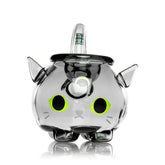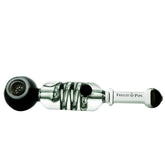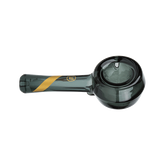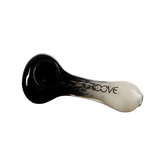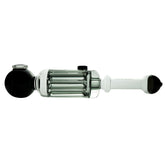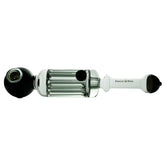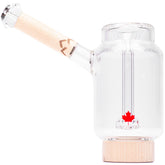-
Vendor:GRAV
GRAV® Helix™ Chillum
The Helix™ Chillum is 3" long and made on 19mm tubing. Its compact Taster® head is fused to a Venturi chamber mouthpiece, featuring three air intake holes that cool and spin smoke. A colored marble prevents the chillum from rolling between uses. No accessories...- $25.99
- $25.99
- Unit price
- per
-
Vendor:Freeze Pipe
The Freeze Pipe
The Freeze Pipe is a glass hand pipe featuring a freezable glycerin coil. When smoke passes through the frozen chamber it’s instantly cooled resulting in an impressively smooth and clean toke for a hand pipe. Ice-cold and extremely smooth hits Freezes quickly and stays...- $59.95
$69.95- $59.95
- Unit price
- per
-
Vendor:GRAV
12mm GRAV® Clear Taster® - Pack of 10
Sometimes you want a Taster with a little more capacity. That's when you reach for the 12mm GRAV® Clear Tasters in a pack of 10 so you'll never run out. These Tasters have a substantial bowl at one end and a mouthpiece at the...- $29.99
- $29.99
- Unit price
- per
-
Vendor:Marley Natural
Marley Natural Spoon Pipe Smoked Glass Gold Stripe Decal
Marley Natural Pipes Smoked Glass Spoon Pipe with Gold Stripe Introducing the Marley Natural Smoked Glass Spoon Pipe with Gold Stripe Decal - a beautifully crafted smoking accessory designed to enhance your smoking experience. With its wide bowl and ample volume, this Spoon Pipe provides...- $39.99
- $39.99
- Unit price
- per
-
Vendor:Marley Natural
Marley Natural Taster Smoked Glass
Pocket-sized and discreet, the Smoked Glass Taster is crafted from handblown borosilicate glass. Its solid mouthpiece offers weight and intuitive balance. The Taster’s deep bowl holds enough for multiple draws, and an ash-catch keeps sessions smooth until cashed.FEATURES Handblown Borosilicate Glass Pocket-Sized Design Solid...- $19.99
- $19.99
- Unit price
- per
-
Vendor:DankStop
Bowling Pin Hand Pipe
Cult Classic Glass Sometimes there's a pipe... I won't say a spoon, 'cause, what's a spoon? But sometimes, there's a pipe. And I'm talkin' about the Bowling Pin Hand Pipe here. Sometimes, there's a pipe, well, it's the pipe for its time and place....- $19.99
$29.99- $19.99
- Unit price
- per
-
Vendor:GRAV
GRAV® Clear Classic Steamroller - Clear - Etch Label
There's a lot of beauty in simplicity. The GRAV® Clear Classic Steamroller is one long uninterrupted tube of crystal clear glass. This piece has smart details like stabilizing glass feet and an inverted ash catching mouthpiece, but otherwise it keeps things clean and smooth....- $19.99
- $19.99
- Unit price
- per
-
Vendor:DankStop
Twisted Pipe
Roller Coaster High This fun hand pipe is made from handblown, borosilicate glass. The deep bowl allows you to pack a little or a lot based on your session. There is a left-side carb to help regulate airflow and cool your hit. The long twist...- $19.99
- $19.99
- Unit price
- per
-
Vendor:Groove
Groove Hand Pipe Frosted Top 4" - BlkFrost
Features Clear Glass With Black Accents Ground Glass Connections Includes 14mm Bowl 4” Length Dry Herb Compatible Description Value glass products that are simple, functional and reliable, the Groove Glass Line is made of high-quality materials with a clean and classic look. Clear glass...- $19.99
- $19.99
- Unit price
- per
- BlkFrost
- Blue
- Green
- pur
-
Vendor:Marley Natural
Marley Natural Spoon Pipe Natural Glass and Black Walnut
Marley Natural Glass & Walnut Spoon Pipe The Marley Natural Glass & Walnut Spoon Pipe combines an ergonomically rounded stem and a heat-resistant glass bowl for a comfortable to use spoon pipe experience. The detachable parts and compact form make this unique spoon pipe...- $59.99
- $59.99
- Unit price
- per
-
Vendor:Freeze Pipe
The Freeze Pipe Steamroller
The Freeze Pipe Steamroller is our largest and most impressive glass hand pipe featuring a freezable glycerin coil. When smoke passes through the frozen chamber it’s instantly cooled resulting in an impressively smooth and clean toke for a hand pipe. At 12 inches long...- $89.95
$99.95- $89.95
- Unit price
- per
-
Vendor:Eyce
Eyce Glacier Spoon - Black
About the Eyce Glacier Spoon Ultra functional silicone rubber dry-herb pipe. This new edition from Eyce is loaded with features. The pipe splits in half for easy access to the pipe’s internal airflow path making it effortless to thoroughly clean the pipe. The airflow...- $29.99
- $29.99
- Unit price
- per
- Black
- Green
- Blue
- Multi-color
-
Vendor:DankStop
Raked Silver Fumed Spoon Pipe - Blue
Fumed glass alone is quite eye-catching. It changes color the more you use it as well as the light you hold it in. The Raked Silver Fumed Spoon Pipe has this fumed glass base underneath a raked color scheme. These color accents come in...- $25.99
- $25.99
- Unit price
- per
- Blue
- Orange
- Teal
-
Vendor:DankStop
Raked Face Spiral Fumed Spoon Pipe - Amber
With interesting patterns and fumed glass, the Raked Face Spiral Fumed Spoon Pipe is an artistic, inexpensive hand pipe that does not break the bank. The entirety of the pipe is made with fumed glass. Fumed glass is becoming very popular because of the...- $25.00
- $25.00
- Unit price
- per
- Amber
- Blue
- Green
- Teal
-
Vendor:DankStop
4” Glass Gem Taster
The 4” Glass Gem Taster provides clean, clear, super smooth hits, all while looking fabulous. It is made from high-quality Borosilicate Glass, features a Decorative Gem-Filled Chamber, and is available in random Assorted Stylish Varieties This one hitter is perfect for smokers on the go...- $9.99
- $9.99
- Unit price
- per
-
Vendor:DankStop
Leafy Green Mushroom Milli Spoon Pipe
The Leafy Green Mushroom Milli Spoon Pipe has quite the relaxing effect thanks to its worked glass artistry. A large green leaf stems out near the bowl on the opposite side of the carb hole. It curves over the body of the pipe and matches...- $24.99
$54.99- $24.99
- Unit price
- per
-
Vendor:Borealis
Borealis 14.25" Beaker Bong
Borealis 14.25" Beaker Bong Experience elegance and functionality with the Borealis 14.25" Beaker Bong from Canada Puffin. This stunning piece features: A hybrid beaker and globe design A sturdy 6.4" integrated magnetic base High-grade, heat-resistant, 5mm borosilicate glass and authentic Canadian-grown Maple wood Superior...- $139.99
$199.99- $139.99
- Unit price
- per
-
Vendor:Canada Puffin
Canada Puffin Chalet Steamroller
Chalet Steamroller Experience the tradition of relaxed smoking with our Chalet Steamroller. Inspired by the brisk Canadian winters, this sleek and iconic piece delivers a dense, full-bodied stream of smoke while cooling with each draw. Key Features: Handblown: Crafted by expert glass makers using...- $79.99
- $79.99
- Unit price
- per
-
Vendor:Krave Glass
Krave Glass Freezable Steamroller Hand Pipe - UV Slime
Krave Glass Steamroller Handpipe Detachable Bowl with Clip for extra support Freezable Chamber Coiled Smoking Shaft to cool air & to show off to your friends HIGHend collection glass Quartz Banger INCLUDED *BONUS* Krave Glass has been a popular brand in the industry since...- $59.99
$69.99- $59.99
- Unit price
- per
- UV Slime
- Blue
- Yellow Pixy Dust
- Green Pixy Dust
-
Vendor:Smoke Drop
Arctic Bubbler
Arctic Bubbler Experience the coolness of the Arctic with the Arctic Bubbler. A perfect fusion of functionality and artistry, this hybrid water and dry pipe is more than just a smoking device; it's a statement piece that encapsulates Canadian heritage and pride. Key Features:...- $119.99
- $119.99
- Unit price
- per
SIGN UP FOR OUR NEWSLETTER
Receive our latest updates about our products & promotions.




